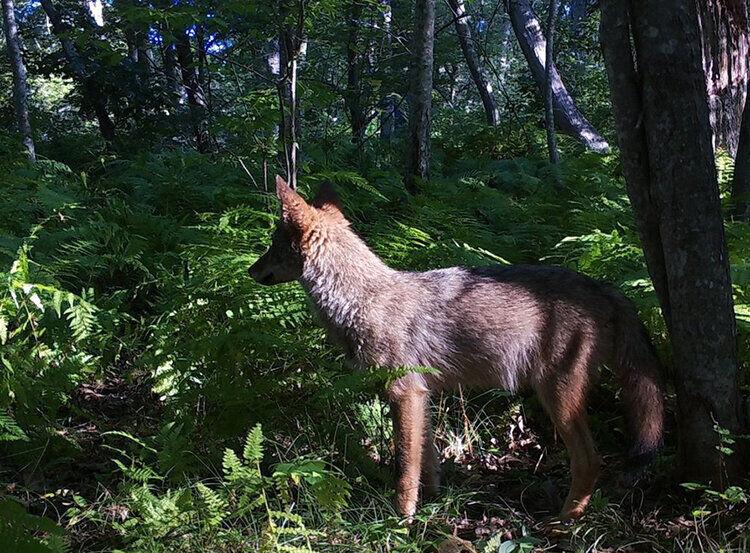
On a recent Friday afternoon, online viewers watched as Numi Mitchell, lead scientist for the Narragansett Bay Coyote Study (NBCS), held what looked like a large antenna in one hand and a beeping device in her other. An osprey cried out overhead, and if it weren’t for the Providence Police Department’s Clydesdale horses in the paddock, you wouldn’t know that Mitchell was in Roger Williams Park.
“She’s here!” Mitchell said, as a particularly loud beep sounded.
She being a female coyote named Whinny, who is making her way through the park along with her three pups. Some other hot spots on Whinny’s travels include a trash collection area in the park and the wind turbines near Save the Bay on Providence’s working waterfront.
The NBCS, which started in 2004, tracks local coyotes, like Whinny, in an effort to observe their movements and populations and to pinpoint unnatural food sources such as trash-disposal areas and farm-animal byproducts.
Coyotes are omnivores, eating a variety of food from berries to bunnies. But they are also opportunistic, and a dumpster can provide an easy meal with little effort.
In her 16 years studying Rhode Island’s coyote populations, Mitchell has found that the increase in the animal’s numbers can largely be attributed to people’s carelessness with food and their compulsion to feed wild animals.
Before coyotes arrived in Rhode Island and other areas along the East Coast, they were dwellers of the broad expanse of prairie in the country’s interior.
“They were originally from the Great Plains,” said Mary Gannon, wildlife outreach coordinator for the Rhode Island Department of Environmental Management’s Division Fish and Wildlife. “But when European settlers came [to New England], they cut down forests and killed a lot of the natural predators in our area.”
Some native predators that predated coyotes in Rhode Island and New England included the gray wolf, mountain lions, and bears. With these large predators gone, there was room for coyotes. They moved in.
“The coyotes expanded their territory to the north and south of the U.S.,” Gannon said.
She said they first arrived in Rhode Island in the 1960s and reached the Narragansett Bay islands in the mid-’90s. Soon after their arrival, the state’s coyote populations began to quickly increase, thanks to ample access to human-produced trash.
“Our tracking efforts started on the islands, particularly Aquidneck Island, which was seeing an explosion of coyotes,” Mitchell said. “We were trying to figure out why they were so abundant. And it’s the garbage that is subsidizing the coyote’s diet. It’s not the coyotes that are the problem; it’s people leaving trash outside.”
While hunting of coyotes is allowed, NBCS has maintained that it’s trash management that is the key to reducing coyote populations.
In 2018, NBCS received a $1.1 million federal grant to fund a five-year study of coyotes in Rhode Island, part of which includes food-removal experiments across the state. Mitchell noted that one of these efforts will be with a farmer in the Coventry village of Greene, whose animal waste and byproduct has attracted and fed coyotes in the area.
Back at the Providence police paddock, Mitchell and her crew try to coax Whinny out from her hiding place to offer a fleeting glance to online viewers. They hop the fence, and with a shaking camera and curious Clydesdales running over to get a piece of the action, it feels like a James Bond film.
Suddenly, they gasp at the sound of paws crunching delicately in the underbrush.
“She just ran by us,” whispered Gabrielle De Meillon, a technical staff assistant for DEM. Whinny is a pixelated streak of gray as she continues on her way to seek out trash and continue her journey through Providence.
"easy" - Google News
September 07, 2020 at 07:55AM
https://ift.tt/2F8tR7Q
Researchers: Coyotes eat whatever is easy, and that means human trash - The Westerly Sun
"easy" - Google News
https://ift.tt/38z63U6
Shoes Man Tutorial
Pos News Update
Meme Update
Korean Entertainment News
Japan News Update
Bagikan Berita Ini















0 Response to "Researchers: Coyotes eat whatever is easy, and that means human trash - The Westerly Sun"
Post a Comment